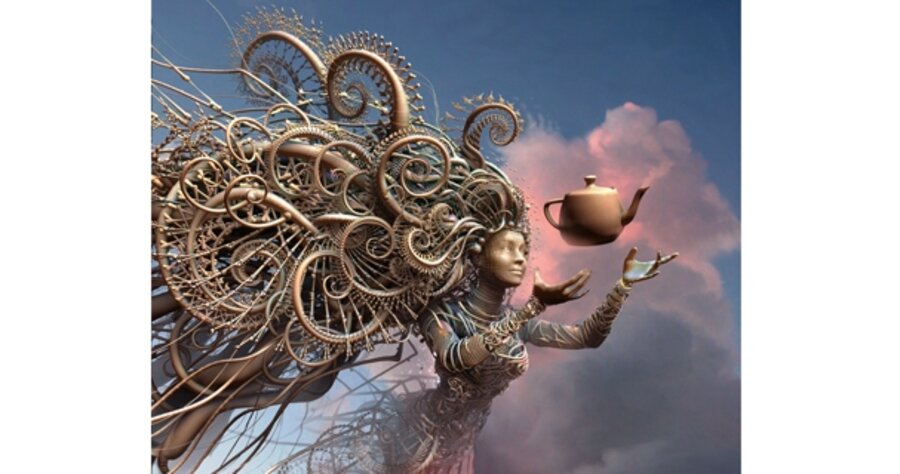A 3-D look down the RabbitHole
Loading...
| Hollywood, Calif.
At first glance, the artworks placed around the small framing workshop in artist Rolando Rodriguez’s tiny studio appear to be blank sheets of Plexiglass.
But switch on an ordinary halogen lamp and suddenly – like a magical Harry Potter family portrait – lush, full-bodied images leap from the unassuming plaques: The outstretched fingers of a mysterious tentacled figure undulate alongside the coils coming from her head; a brooding, Gollum-like creature slinks at the rear of a room, then leaps out; and two skeletal beings lock in an embrace as they hover in the air.
These are the creations of a handful of pioneering digital 3D artists whose show (RabbitHoles 3-D Motion Holograms) launches the newly opened Gnomon Gallery, a showcase for entertainment-industry art in the heart of Tinsel Town.
But it is not just the images that are remarkable, say industry observers. It's new technology developed by RabbitHoles Media that enables them to display up to 12 seconds of animated holography that is having its “coming out” with this show.
The compelling visual effect is not reliant on video or movie film and does not require any special glasses. Rather, the RabbitHoles technology produces both the three-dimensional quality and animated movement from a single flat surface. It cutting-edge posters carry the potential of revolutionizing the worlds of entertainment, advertising, and art.
Filmmaker James Cameron (“Titanic”) has dubbed the new technology “the Holy Grail of advertising.” Eric Miller, a digital artist and the director of online training for the Gnomon School of Visual Effects notes, “A new medium for artists to explore doesn’t come along very often, and this is one that really needs to be seen.”
Perhaps the most telling response comes from within the ranks of the Hollywood technorati. “It’s a glimpse of the future,” says Josh Greer, president and cofounder of RealD, one of the industry’s leading providers of 3-D technology. “Everyone in this town is interested in 3-D and this,” he says, shows “what the next stage will look like.”
RabbitHoles offers startling realism, but only for 10 to 12 seconds of motion. That’s not enough for a normal 30-second advertisement, but the moving holograms have already produced a handful of movie-theater ads, special effects in theme park rides, and a sprinkling of holographic art pieces.
Thanks to several years of research and development by laser technicians and optical engineers in Canada, crisp-moving 3-D images once seen only on a computer, or with special glasses in movie theaters, have finally been realized – and in an easily portable format.
The advance that makes such compelling effects possible is the development of a three-color pulsed laser that is better than the previous two technologies – continuous wave and single-color pulsed lasers. The new pulsed lasers require only a one-ten-millionth-of-a-second spurt of red, green, and blue light, whereas previous systems employed a low-intensity lamp, which required exposure times lasting from just under one second to a few minutes. Unintended vibrations during these longer exposures lead to diminished resolution of the hologram.
RabbitHoles Media brought the technology to the United States in 2007 – and the company refers to each finished hologram as a “RabbitHole.”
Veta Bates, the company’s director of creative affairs, says RabbitHoles work much like flip-books because they reflect image sequences into the space in front of the print. But in this case, viewers walk past the images to make them change, rather than flipping pages with their thumbs. There are up to 1,280 different “pages” in each RabbitHole, she says.
RabbitHole software uses special algorithms to determine what you see. “Your eye and brain meld the images back together seamlessly and the image appears to move as you move around the poster,” says Ms. Bates.
In a two-dimensional world, a pixel is the smallest piece of information in an image. If you look closely enough, newspapers and computer screens are little more than grids of dots. In the 3-D world of RabbitHoles, a poster-size print contains about 275,000 holopixels, each with 1,280 angles or perspectives, meaning the viewer is actually seeing 353 million bits of visual information.
Data from virtual or digital cameras is sent to a printer, which divides each frame into holopixels. The finished product is transferred to Plexiglas, which can be framed and mounted. A halogen lamp is then shined onto the surface from above or below at a 45-degree angle, which produces the three dimensional effect. When examined closely without illumination, the finished print looks like thousands of ant-width boxes.
While the new technology seems promising, it faces obstacles to mainstream consumer usage, most notably the high costs and technical complexity of production. A single movie-poster-size piece takes four hours to print, and costs $2,000.
“We’re working on bringing down the prices and speeding up the production process,” says RabbitHoles CEO Todd Allan. Everyday usage, such as in animated holographic family snapshots, is certainly a goal, but at the moment, prices for single limited-edition prints in the upcoming show at the Gnomon Gallery run about $2,400.
The detailed modeling also has applications in science, architecture, and even museums, where it can be used to catalog collections.
While the technology is taking its bow in the heart of the entertainment industry (it appeared last summer at a comic book convention in San Diego, but Mr. Allan calls that “a dress rehearsal”), the artists themselves say the medium opens a new door for them as well.
“It is wonderful to have a display method for my 3-D artwork, which was created in virtual 3-D space and really should be shown in three dimensions for the full effect,” says Meats Meier, an artist featured at the Gnomon Gallery. “Printing my 3-D-created artwork onto a flat, boring canvas [has been] very depressing to me. I want to see it come alive and breathe its digital breath.”





